To mark today’s screening of Black Narcissus as part of the series of Exeter Screen Talks, I wanted to celebrate twenty films about convent life. The emphasis is on movies that make some serious attempt at portraying religious life, and I have therefore ignored those with fake nuns (A Mule for Sister Sarah (1970) and Più forte sorelle (Renzo Spaziani, 1973) as well as the more lurid examples of the nunsploitation genre (Behind Convent Walls (1978), Sacred Flesh (1999) etc) but at the end of the day the selection is a personal one and is as arbitrary and subjective as can be.
The Convent Gate (Wilfrid Noy, 1913)
Straightaway I’m cheating by writing about a film that I haven’t seen. It’s been estimated that between 75-90% of silent films were destroyed or disappeared, and sadly The Convent Gate was one of them. My interest was piqued when I came across this postcard at a flea market some years ago, and I wrote a little bit about it in a previous post.
Ten years later Lilian Gish starred in this adaptation of F. Marion Crawford’s 1909 novel The White Sister. It had been filmed already in 1915 with Viola Allen in the title role, as star-crossed Italian lover Angela Chiaromonte who enters religious life after a series of tragic events, plotting and misunderstandings. Ronald Colman played her lover, Captain Giovanni Severini.
The story is set in Italy and ends with the climactic eruption of Vesuvius. While in Sorrento five years ago I came across a street named after Crawford – he moved here in the 1880s and knew the area well.
The White Sister (Victor Fleming, 1933)
In the third screen adaptation of Crawford’s novel Angela was played by Helen Hayes, who was about to make her name playing Mary Queen of Scots and Queen Victoria on Broadway. Colman’s role was taken here by Clark Gable.
Les Anges du Péché (Robert Bresson, 1943)Comparisons are often drawn between the work of Bresson and Bill Douglas, both of whom excelled in the use of poetic imagery with minimal dialogue. Bresson was still finding his style with Les Anges du Péché, his first feature film, made in wartime France in collaboration with Dominican friar Fr. Raymond Bruckberger O.P. and playwright Jean Giraudoux. ‘Angels of Sin’ follows events in a religious community dedicated to rehabilitating women prisoners, but it is easy to see the German occupation of France as influencing the themes of incarceration and vengeance killing.
Bells of Saint Mary’s (Leo McCarey, 1945)
Ingrid Bergman and Bing Crosby star in this drama as Sister Mary Benedict and Father Charles O’ Malley, fighting to save their city school from closure. Both of them get to sing in the movie of course, Bergman singing the traditional Swedish folksong Varvindar Friska (Spring Breezes) and Crosby crooning the title song (along with a choir of nuns) and others. The movie is used in the film The Magdalene Sisters (Peter Mullan, 2002) with bitter irony – the sweet nuns of the 1945 film contrasting harshly with the cruel, somewhat cartoonish villains of Mullan’s tale.
One of my favourite films of all time, and my strongest recommendation of all those listed here, Black Narcissus is based on Rumer Godden’s 1939 novel and tells the story of a community of nuns opening a convent in the Indian Himalayas. As with so much of Powell and Pressburger’s work, the film is imbued with a strong sense of place and an awareness of the effect of location on human behaviour: the lush sensuality of the landscape (filmed in vibrant Technicolor by Jack Cardiff) and the erotic history of the convent building (a former seraglio) seem to draw out the emotional tensions and desires of the nuns – in particular Sister Ruth (below.)
The magnificent cast also includes Deborah Kerr, Flora Robson, Jean Simmons, Esmond Knight and a surly, swaggering David Farrar.
Another tale of nuns moving into an unfamiliar location, but very different in tone, Come to the Stable starred Loretta Young and Celeste Holm as two French nuns trying to establish a foundation in Bethlehem, Connecticut. Unlike the plot of The Bells of St Mary’s the nuns don’t resort to trickery to achieve their goals…
Thunder on the Hill (Douglas Sirk, 1951)
This who-dunnit is set in a storm-lashed Norfolk convent, where convicted murderess Valerie Carns (Ann Blythe) gets marooned by the weather while en route to the gallows. (Ruth Ellis, the last woman hanged in Britain, died four years later, in 1955.) Claudette Colbert plays Sister Mary, a young nun who begins to have doubts about Valerie’s guilt – setting her on course to clash with the Mother Superior (Gladys Cooper.)
Heaven Knows, Mr Allison (John Huston, 1957)
Having played the Sister Superior in Black Narcissus, Deborah Kerr was demoted to the status of a novice in this film, in which she is stranded together with US marine Robert Mitchum on a Pacific island during WWII. They have to deal with lack of food, fever, Japanese soldiers and – of course – each other, while waiting to be rescued. Both stars give tremendous performances, while the exotic location (much of it was filmed in Tobago) provides a lush backdrop to the poignancy and drama of their situation.
The Nun’s Story (Fred Zinnemann, 1959)
Based on Kathryn Hulme’s 1956 novel, The Nun’s Story follows Sister Luke (Audrey Hepburn) as she struggles to deal with inner conflict as a medical nun working in Africa. As with The White Sister and Black Narcissus, there are hints of an unresolved romance haunting her decision to enter the convent, but Sister Luke also has to deal with issues regarding obedience and her duties towards her family and homeland after the Nazis invade Belgium while she is working in Africa. It’s one of the best films for a serious exploration of the real issues involved in taking the veil.
(Philippe Agostini, 1960) This was another wartime project of Fr Bruckberger O.P., based on Gertrud le Fort’s novel about a community of Carmelite nuns who were martyred at Compiegne in 1789 during the French Revolution. George Bernanos wrote additional dialogue – much of which was later dropped – and stage and opera versions were produced before the screenplay finally made it to the screen. Jeanne Moreau played Mère Marie de l’Incarnation.
(Jerzy Kawalerowicz, 1961) Based on the same story about the possessed nuns of Loudun that inspired Ken Russell’s film ten years later, Mother Joan of the Angels is much less well known: this is a shame, as it’s an absolute masterpiece, subtle in all the places where Russell is extravagant, yet containing a wealth of stark, stunning imagery and poetic visuals.
Lilies of the Field (Ralph Nelson, 1963)
This film provided Sidney Poitier with his first Oscar, playing wandering handyman Homer Smith who finds work (but no wages) helping out a struggling community of nuns from German and Eastern Europe. The title of the film is taken from Matthew 6:28-30, which Mother Maria (Lilia Skala) quotes in response to Homer’s request to be paid.
Maria von Trapp’s memoir The Story of the Trapp Family Singers provided the basis for a Rodgers & Hammerstein musical which was in turn adapted for the screen by 20th Century Fox. Julie Andrews played Maria, a novice nun who leaves the convent for a while to work as a governess to an Austrian family of seven children, and ends up leaving religious life and marrying their widowed father. Some of the exterior scenes were shot at the convent of Nonnberg in Salzburg.
The Nun (Jacques Rivette, 1966)
Denis Diderot’s novel La Religieuse, published in 1796, offers a profound critique not only of religious life and Catholicism but also of the constraints placed upon women in 18th century society. Diderot’s simple tale recounts the sufferings of a young girl, Suzanne Simonin, who is forced into the convent by her family. French New Wave director Jacques Rivette adapted the novel for the stage before revising it for the screen, in both versions casting Jean Luc Godard’s then-wife Anna Karina as Suzanne. It remains quite stagey, with its slow pace and unadorned style, but it’s deeply moving and heartbreaking in its depiction of Suzanne’s ordeals as she experiences religious life under three Mother Superiors – the kindly Madame de Moni (Micheline Presle), cruel Sister Sainte-Christine (Francine Berge) and the ardent Madame de Chelles (Liselotte Pulver.) The film was remade by Guillaume Nicloux in 2013 with Isabelle Huppert playing Suzanne.
The Trouble with Angels (Ida Lupino, 1966)
Returning to the present day and a lighter vein, The Trouble with Angels was set in an American convent school where rebellious pupils Hayley Mills and June Harding try to outwit the Mother Superior (Rosalind Russell), only to find that they underestimate the nun’s wisdom and wiles. The success of the film inspired a rather lacklustre sequel, Where Angels Go, Trouble Follows (James Neilson, 1968.)
‘The Singing Nun’ was the popular name given to Sister Luc-Gabrielle O.P., also known as Jeanne Deckers (1933-85), a Dominican nun from Belgium who released several records including the No.1 single ‘Dominique’ (1963.) The movie is a sweetly fictionalised portrait of Deckers, whose life subsequently took a tragic dive downwards into depression, drug abuse and suicide.
Change of Habit (William Graham, 1969)
Elvis Presley’s final fictional movie role saw him play a doctor in a run-down area who is unaware that three co-workers – Michelle Gallagher (Mary Tyler Moore), Irene (Barbara McNair) and Barbara (Jane Elliott) are in fact nuns who have shed their habits in order to gain the trust of the parishioners they are trying to help. The movie, as one would expect, contains romantic entanglements and lots of Elvis songs.
As a by-the-by, it is perhaps worth mentioning that another of Elvis Presley’s co-stars, Dolores Hart – who played opposite ‘The King’ in Lovin’ You (1957) and King Creole (1958) – entered a real-life convent in 1963 and later became the Prioress of Regina Laudis Priory in Connecticut.
The Devils (Ken Russell, 1971)
It’s been over forty years since the release of The Devils but Ken Russell’s extraordinary and disturbing work has retained its reputation as one of the most shocking movies ever made in Britain. The scenes of orgiastic violence are graphic and unrelenting, but shot with the high command of visual aesthetics that one would expect from production designer Derek Jarman. Although Vanessa Redgrave played Mother Jeanne of the Angels, the role had been originally offered to Glenda Jackson. However, after playing the female leads in Russell’s Women in Love (1969) and The Music Lovers (1970), a third erotically-charged performance might have been excessive (even for them.) As a representation of convent life The Devils cannot evade the charge of sensationalism – it’s a orgy of Grand Guignol grotesquerie and Gothic horror – but it explores aspects of religious psychology and the interior life that are barely touched by the other films listed here. Go there if you dare.
Nasty Habits (Michael Lindsay-Hogg, 1977)
It wasn’t long Jackson got another chance at playing a nun, and this time she accepted the offer: Nasty Habits is based on Muriel Spark’s novel The Abbess of Crewe: A Modern Morality Tale (1974), which took the then highly-topical story of the Watergate scandal (1972-74) and transposed its component parts into a Benedictine convent where a power-hungry nun is plotting to fix her election as abbess. The film version shifts the setting from Crewe to Philadelphia and assembled a star-studded cast that included Edith Evans as the old Abbess Hildegard whose death leaves a power-vacuum, Glenda Jackson as the ambitious Sister Alexandra (i.e. Nixon) and Geraldine Page and Anne Jackson as her accomplices Sisters Walburga and Mildred, who break into the sewing basket of her rival Sister Felicity (Susan Penhaligon) in order to steal a cache of love letters. Allegations of bugging and bribery lead to Vatican involvement, and those familiar with the Watergate story will enjoy identifying the characters and events being parodied.
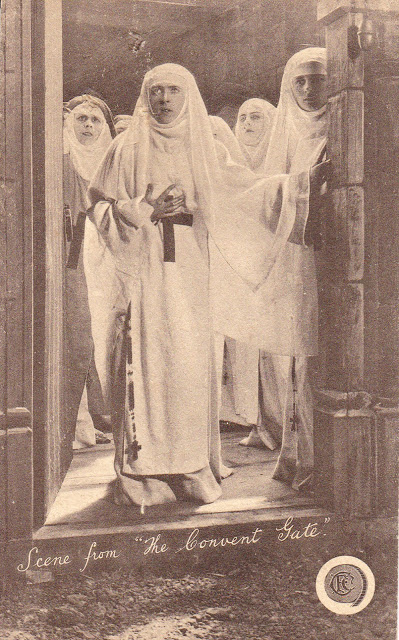

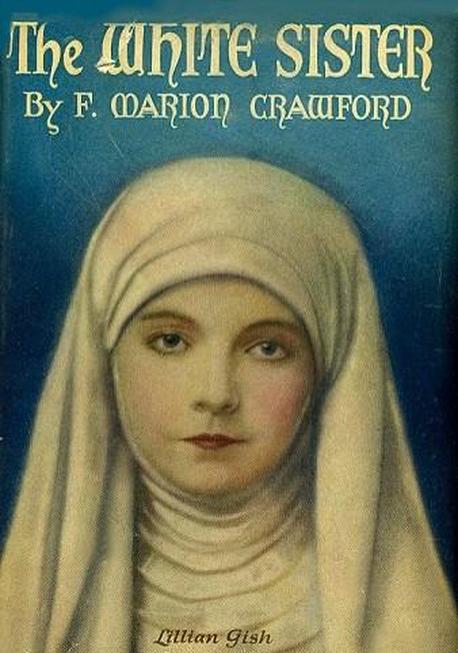


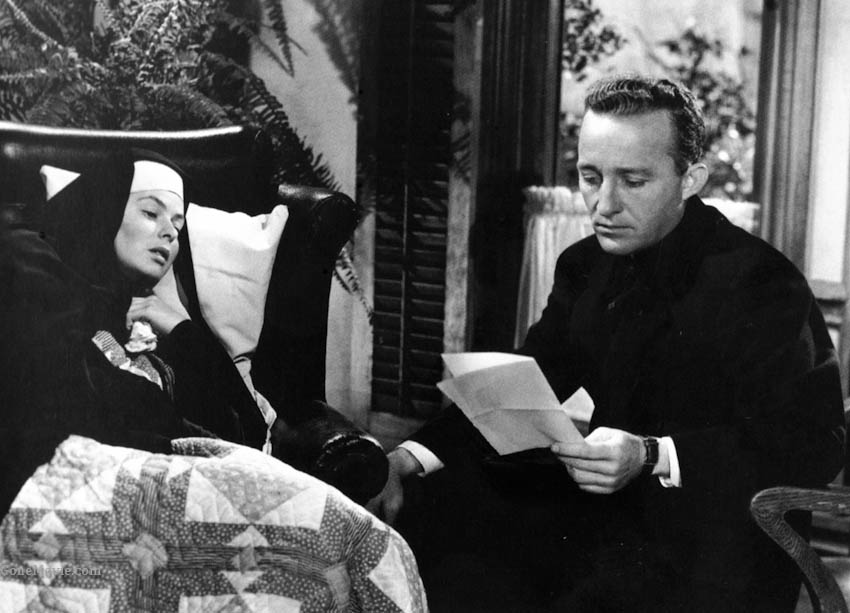



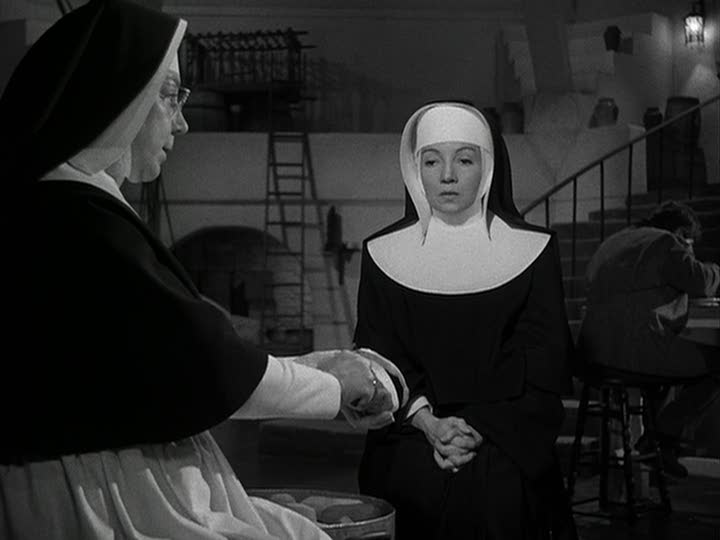
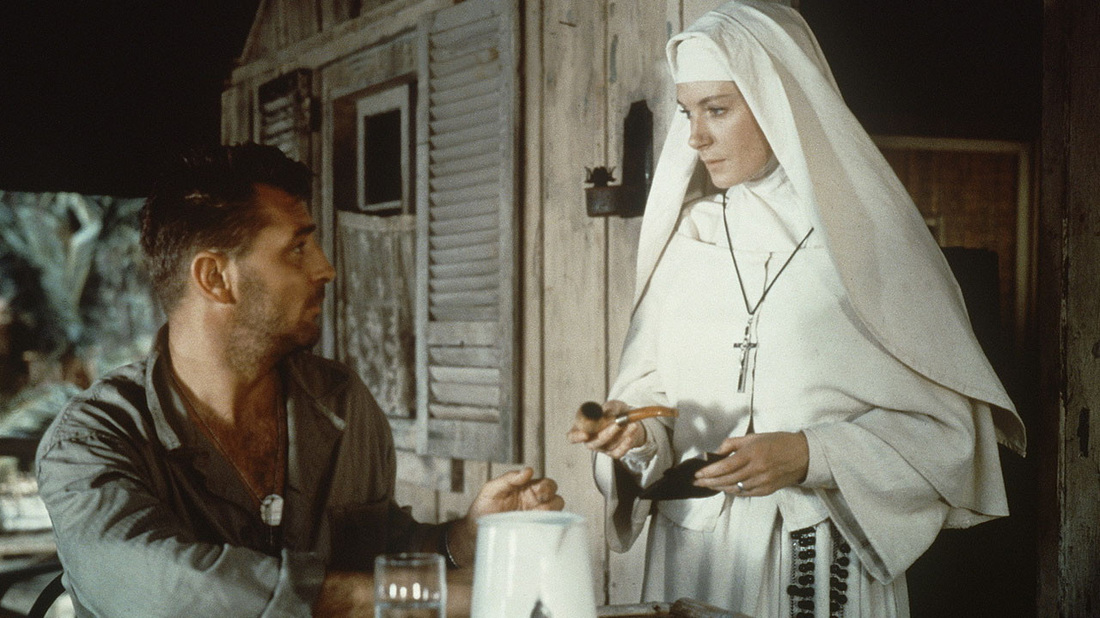

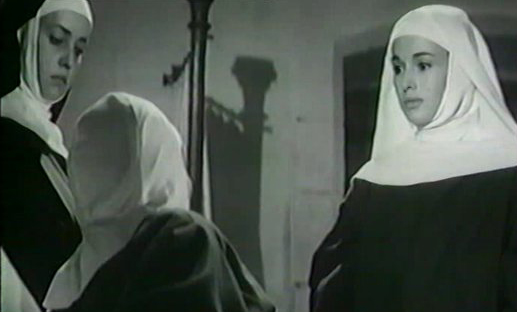
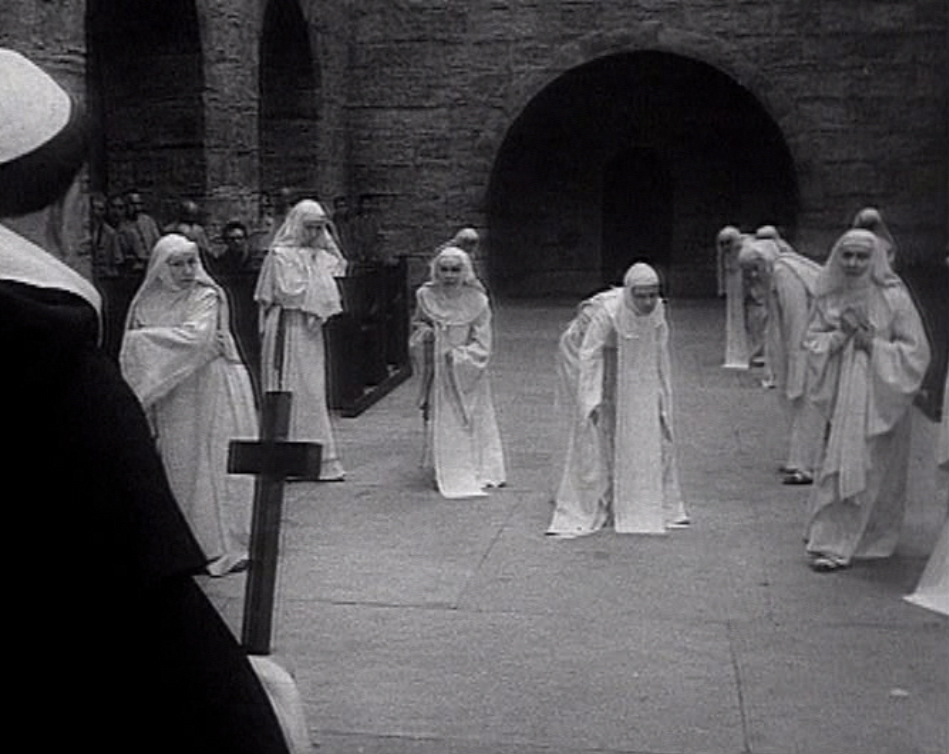
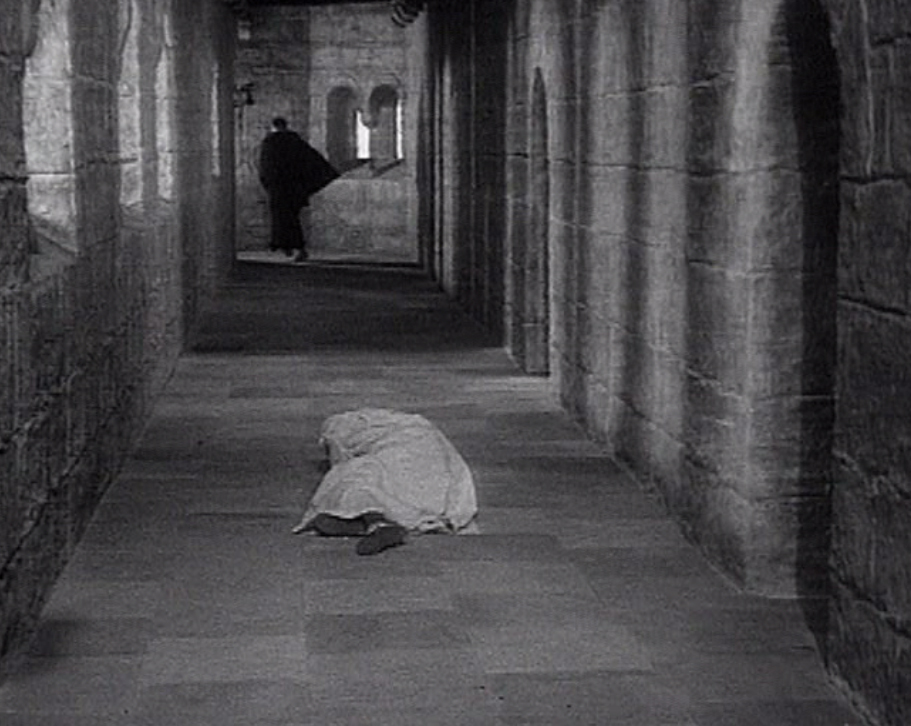

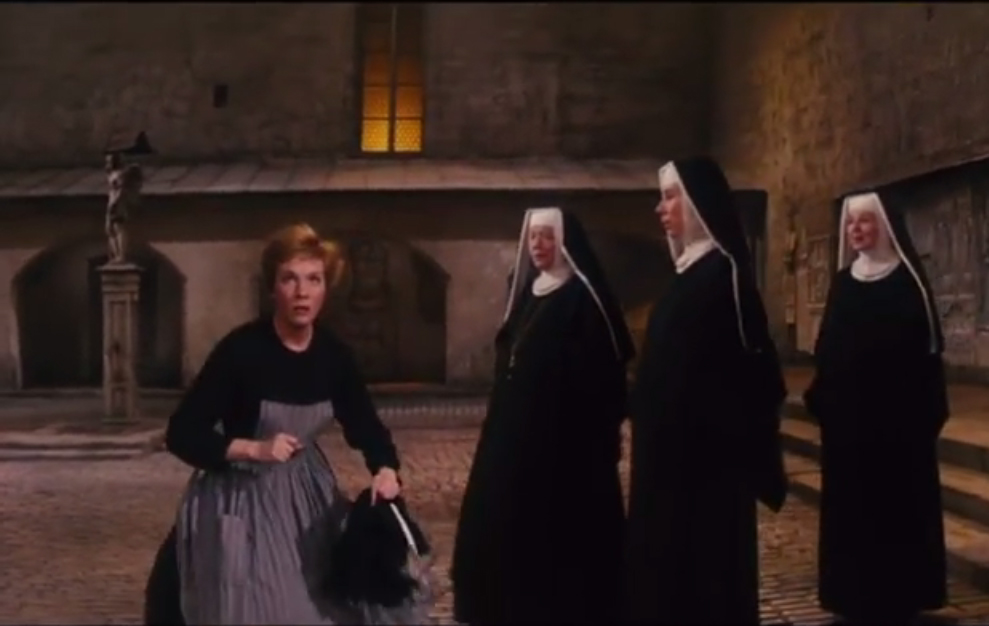

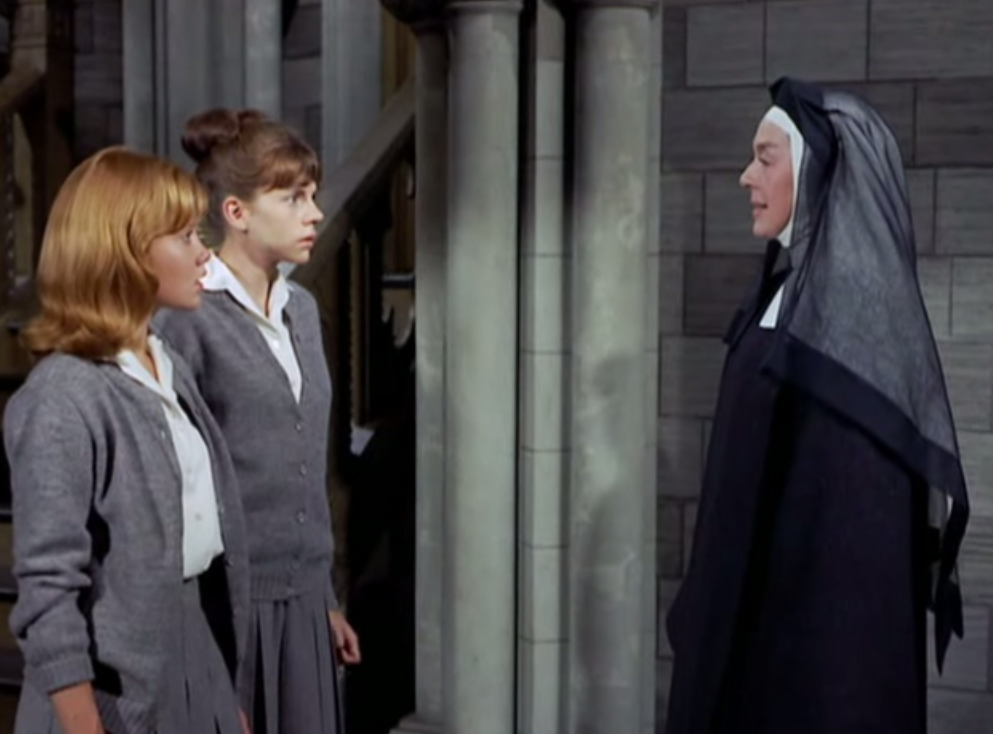
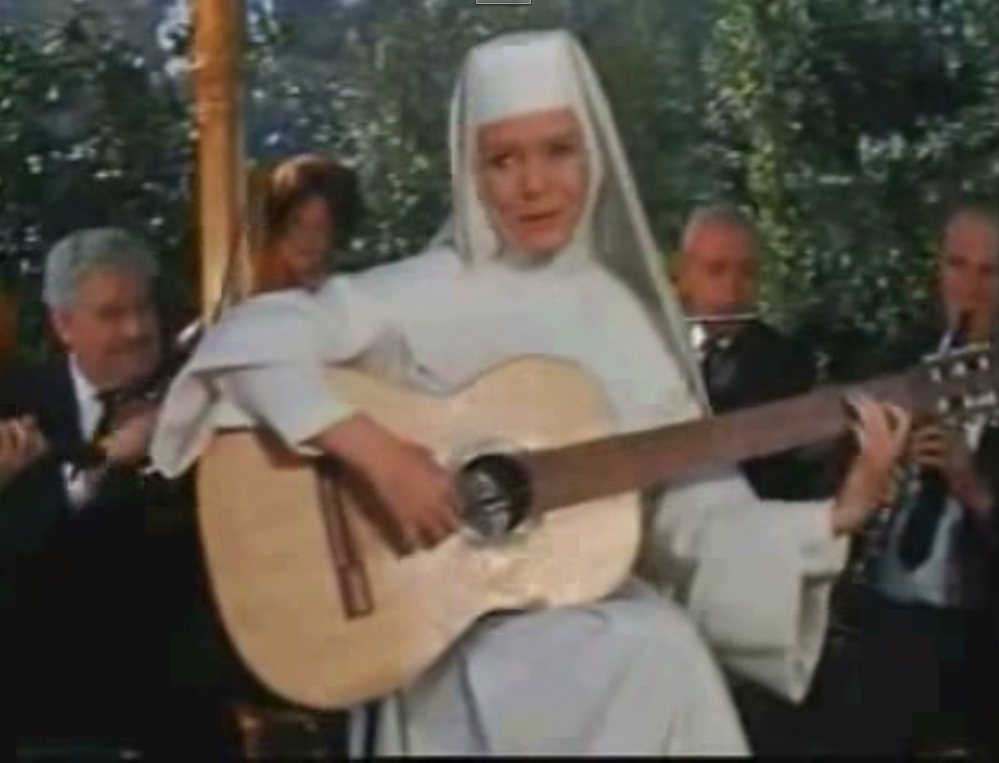
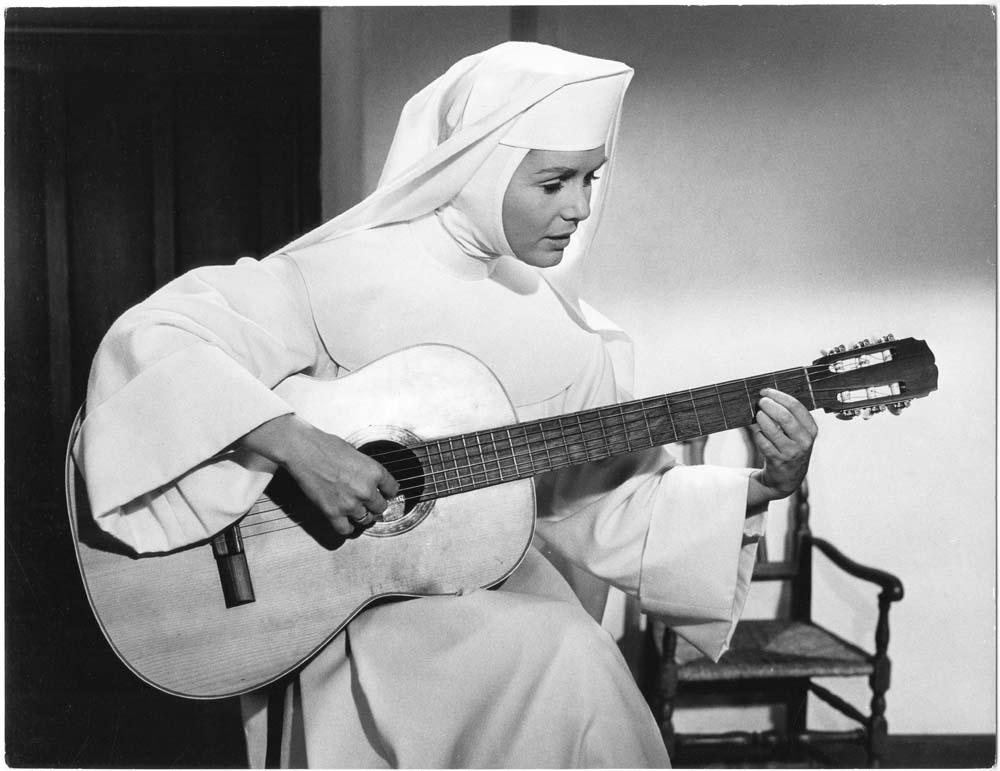
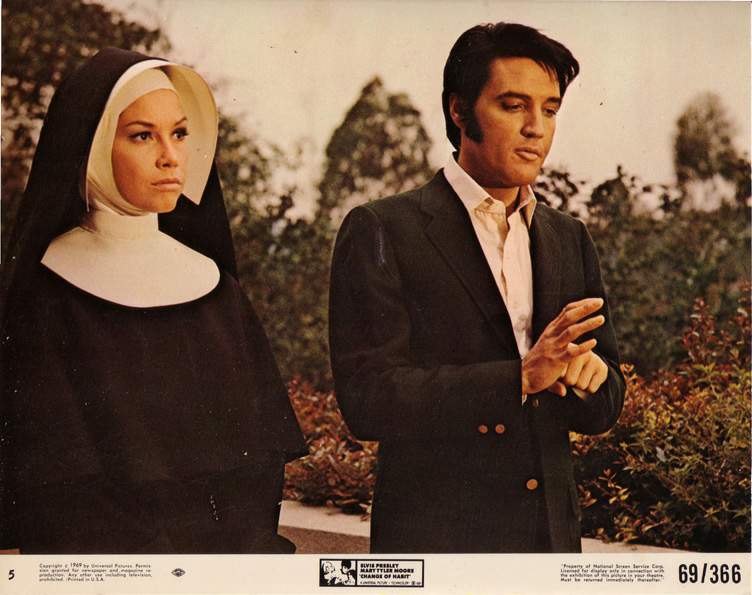
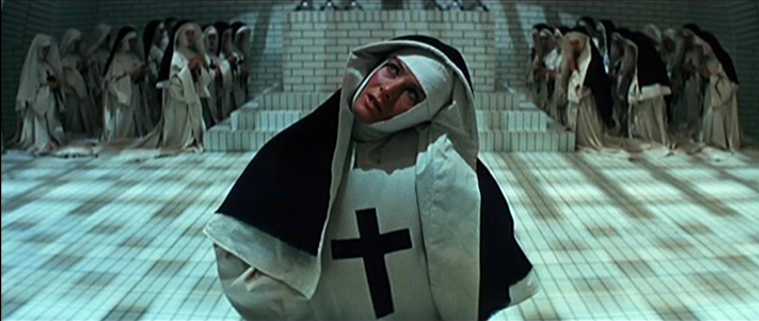
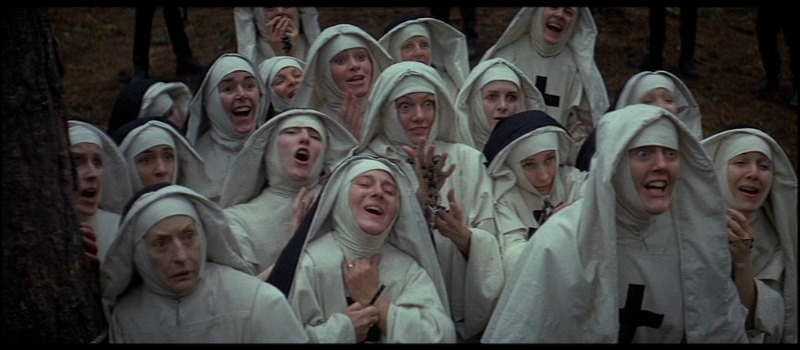

Really enjoyed the list of movies but particularily enjoyed your synopsis & comments.
Love this post. I have seen many of these movies including Ken Russell’s “The Devil’s”, but I haven’t seen “Mother Joan of the Angels”. I’ll have to try to find that and Jacques Rivette’s “The Nun”, as I’d like to see them both.
Have you seen the TV adaption of Rumer Godden’s “In this House of Brede”, with Diana Rigg in the principle role? It is an excellent film even if it was made for TV. I really think my favorite of all of these is “Black Narcissus”, also based on a Rumer Godden work as you noted. Just a superb film, fantastic performances and some of Jack Cardiff’s most lushly beautiful cinematography.
By the way, the picture you have above is not Kathleen Byron, it is in fact the inimitable Deborah Kerr. Byron’s cheekbone’s and eyes are unmistakable, as is the sneer that seems to be on her face in every frame that she happens to be in, in this movie. Her work in this movie is so compelling, and utterly chilling, that it actually can divert attention away from Deborah Kerr, who is also superb here.
There are a number of really good movies listed here, but surely “Black Narcissus” is the cream of the crop (or in the top three, as I have not seen all of these films). I have always been fond of “The Nun’s Story” too, but more so because I really thought the book was terrific. However, the movie does not do the book justice. It cannot delineate the inner struggles of Sister Luke as well as the book can; and I’ve never been fond of Audrey Hepburn as an actress, though she gives a good performance in the movie. Another of my favorites is the Lillian Gish version of “The White Sister”, which I thought was really well done, though the Helen Hayes version has its moments too. In fact, many of these movies were quite well done.
I also remember seeing a Ramon Navarro movie where he plays a singer who wants to sing popular music, while his teacher wants him to pursue a classical/opera career. He is overheard by a young novice in a convent next door to the cafe where he is performing, and she winds up leaving the convent for him, and they fall in love and run away together, intending to marry. She had entered the convent largely because it was her brother’s wish. Later, found by her brother and encouraged by her fiancee, who is courageously giving her up, so she can have a better life than he believes he can give her, she returns at her brother’s insistence, and because she believes she is sinning by loving a man. In the end, the Mother Superior assures her that her vocation must be her own choice, not her brother’s, and that she incurs no moral approbation for leaving the convent to marry the man she loves. It is a very early talkie and you hear Navarro actually singing in it. I wish I could remember the name of it because the look at convent life is quite interesting – would you happen to know what the name of it is? If you haven’t see this move it is also well worth your time; it is a rather simplistic plot and typical in many ways of early films but quite enjoyable.
Thanks for writing this entertaining and informative post – I enjoyed it.
Dear Loren,
Thank you so much for taking the time to share your comments and thoughts about the movies featured in my blogpost. I’m in complete agreement with you about ‘Black Narcissus’, which is by far my favourite of all the films here. Many thanks too for pointing out my careless slip with the BN caption, which I have now corrected. I don’t think I’ve seen the Diana Rigg movie of ‘In this House of Brede’ but as I’m a fan of Godden’s work I really should do so. If you do manage to see any of the other films here, let me know your opinion about them. The Navarro film you mention is ‘Call of the Flesh’ (Charles Brabin, 1930.) It’s not officially available on dvd but some copies can be found, and there’s a nice little write-up here:
http://pre-code.com/call-flesh-1930-review-ramon-novarro-dorothy-jordan/.
Wonderful site. Of course it needs saying that Black Narcissus focuses on an Anglican religious order in the days of Imperial splendour in India. Most Anglican religious orders had provinces in India. I have worked with some Anglican Sisters who were founded to work in Tanzania which they did with heroic sanctity. Their stories are amazing and open up a whole new unmined source of material.
Many thanks for your comments, Peter. By any chance did the Sisters with whom you worked belong to the Community of the Sacred Passion? You’re quite right about the cloud of unknowing that seems to obscure so much of the lives and works of these nuns, and sadly, it’s still common to meet people who are quite unaware that Anglican religious communities even exist, far less know anything about their fascinating stories. As you say, it’s potentially a rich source of material for future books or films – we wait in hope!
I enjoyed reading your list and reviews of nun films, many of which I’ve seen and enjoyed, but I have learned of unwatched pleasures to come, so thank you very much!
Having trawled the internet many times for a copy of ‘In This House of Brede’ (available on DVD in a couple of places, but criminally expensive!) I eventually found it free in two parts on YouTube. It isn’t quite as good as I remember from seeing it on TV when it was released years ago, but it is enjoyable none the less. However, it’s not a patch on the original book and, in some parts, has been changed completely.
My personal all time favourite has to be ‘The Nuns’ Story’ and I do think, given obvious constraints of time etc. it does follow the book reasonably faithfully. I wish there was a sequel though – I always want to know what happens to Sister Luke after she turns that corner and disappears from view!
Thanks for taking the time to comment, Ann, and I’m glad you enjoyed the post – hopefully you’ll be able to track down the films you haven’t yet watched: do let me know your views once you’ve seen them! Yes, it would be marvellous to know what Sister Luke went on to do next, but I fear the time for making a sequel has passed now. Another actress and modern film styles would probably make it feel like a very different Nun’s Story.
‘In This House of Brede’ is good in terms of the authenticity of its depiction of convent life, especially the liturgy, but anyone who’s read the novel is likely to miss the vast amount of material and characters that didn’t make it into the film. It’s hardly surprising – my paperback copy is over 400 pages – but it’s such a wonderfully rich story that it could really have done with being adapted into a series, so we could spend time with the likes of Dames Maura and Veronica. Maybe this will happen some day. I didn’t include the ‘House of Brede’ TV film here because I was concentrating on the big screen, so I’m grateful to you for bringing it up.
Good post. Thank you !
Yes, I loved this post too. I was going to ask you about “In This House of Brede” too but see others have already said this. (That said, I much preferred the book). Of the available films above that I would particularly love to see, two are Mother Joan of the Angels and Dialogue des Carmelites, which sound intriguing.
There is one missing. If you like these movies, you should check this one out, The Very Private Work of Sister K. As sister K explore sex with a innocent perception, a clash between sister K and the church is on the go. Rated No.7 2016 must watch. Controversial but not obscene.
https://vimeo.com/ondemand/sisterk
Thanks for the recommendation, Cado – I’m always keen to hear about new work and will look this up, although I think there’s a lot more than just ‘one’ missing from this list – it was a personal selection and I’m sure a comprehensive list would run into three figures. Maybe I’ll attempt a longer list in the future, one that could include ‘The Very Private Work of Sister K.’
With so many excellent comments here, may I still add my two cents, coming as I do from the viewpoint of an Anglican Benedictine nun and hermit? I couldn’t begin to name the movies and other forms of entertainment in which nuns are either cast as angry, frustrated women, or presented as if they were nothing more than bad jokes. The number of everyday people who think today’s nuns are straight out of “Sister Act” or, conversely, “The Nun’s Story” is beyond counting. The first movie’s stereotypes are evident; those in the latter, less so. Both book and movie present these women from the imperfect point of view of Sister Luc, who was never meant to be a nun in the first place. Given this premise, it’s understandable that she sees her superiors as quasi-dictators. Her viewpoint is gently–spiritually, even– “warped” from the beginning of the movie until the end.
I’d like to compare the above movies with “Two Mules for Sister Sarah.” Actually, I don’t see this movie as an inside joke, a whore pretending to be a nun in order to–safely–help the Mexicans fighting against the French invaders. As Sister Sarah, Shirley McClain had to be faithful to the way a genuine nun would appear and behave, so that the characters and the audience would believe (at least for a while.) She prays; she doesn’t drink or smoke in front of others; her habit is worn correctly; she does not use foul language.
Stereotypes are strange things to me. When I was younger in monastic life, I thought they were mostly gone in this modern day. Sigh . . . . One day I was in the market looking for apples. Nearby was a young mother with a screaming toddler who should have been at home napping. No amount of pleading or cajoling could get him to stop. Finally she caught sight of me in my black habit and veil; she pointed at me; and she said to her son, “If you don’t shut up NOW, I’m going to get that nun to come over here and beat the sh-t out of you!” You can’t imagine my shock and anger as I–and other shoppers, too–heard what she said. The boy was silent, but he looked terrified. I walked slowly to the woman, looking only at her son, and in a quiet voice explained that I would NEVER do anything to hurt him, and why. Before moving on with my shopping, I looked at the mother, smiled, and gave her a small paper on which I had put my name and phone. She never called me.
Dear Sister Elias, Thanks so much for taking the time to comment. I’d certainly agree with you about the frequent negative portrayals of nuns on screen, something that seems to stem from both laziness and ignorance – because the figure of a nun is so easy to depict without much effort, some filmmakers treat them as stock characters with all the two-dimensional, sterotyped and misinformed traits that come with this. It’s rare that time and effort is spent trying to develop a more nuanced, interior understanding of the religious life, its motivations and the psychological demands that are made on those who choose that path. The story about the market shocked and saddened me.